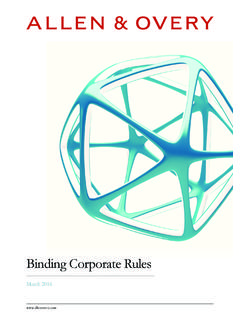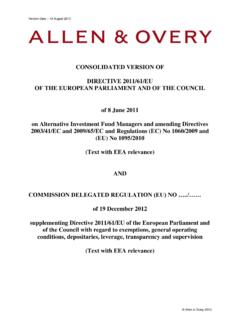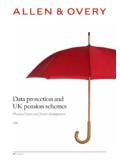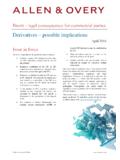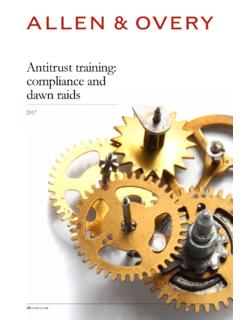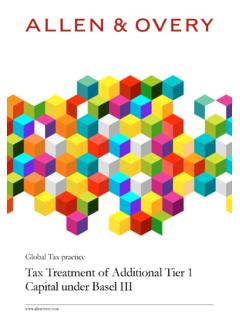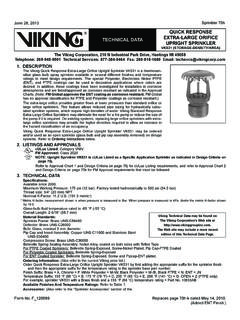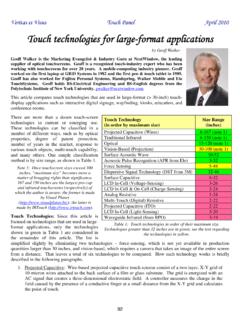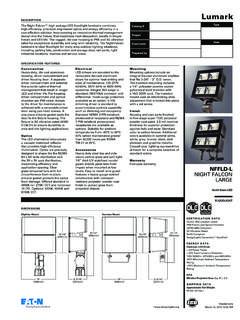Transcription of Capital Requirements Directive IV Framework …
1 Capital Requirements Directive IV Framework large Exposures Allen & Overy Client Briefing Paper 12 | January 2014. 2 CRD IV Framework : large Exposures | January 2014. CRD IV Framework : large Exposures This briefing paper is part of a series of briefings on relevant to the in-house lawyer. This briefing is for the implementation of Basel III in Europe via the general guidance only and does not constitute Capital Requirements Directive IV1 (CRD IV) and definitive advice. the Capital Requirements Regulation2 (CRR), replacing the Banking Consolidation Directive3 and NOTE: In relation to the topics discussed in the Capital Adequacy The legislation is this briefing, the CRR contains a number of highly complex: these briefings are intended to discretions for member states in relation to provide a high-level overview of the architecture of national implementation. The regime may the regulatory Capital and liquidity Framework and therefore differ across member states in a to draw attention to the legal issues likely to be number of respects.
2 1 2013/36/EU. This briefing paper is based on information 2 Regulation 575/2013. 3 2006/48/EU. available as of 17 January 2014. 4 2006/49/EU. Background and scope Sources The large exposures regime is a key plank of regulation CRR (Regulation 575/2013): Part 4 Articles 387-403. of the financial sector. It is important to ensure that UK Financial Conduct Authority (FCA) Policy firms and other regulated entities diversify their Statement (PS13/10) CRD IV for Investment Firms exposures. The large exposures regime aims to protect (December 2013). against systemic risk and the risk of a firm failing as a result of the failure of a market participant, by requiring PRA Policy Statement (PS7/13) Strengthening Capital firms to avoid undue concentration of risks in any one standards: implementing CRD IV, feedback and final counterparty or group of counterparties. rules (December 2013). This briefing paper discusses the scope of the large exposures rules under the CRR in the context of a UK PRA Supervisory Statement (SS16/13) large regulated firm under the supervision of the Prudential exposures (December 2013).
3 Regulation Authority (the PRA). Allen & Overy LLP 2014. 3. Introduction The large exposures regime requires banks and significant reliance by one firm on any given investment firms to monitor and control their large counterparty, the rules also place limits on the exposures. This entails identifying and reporting on maximum size of banking book exposure which a large exposures. firm may have. In addition, to ensure due diversification of firms' The Requirements apply on a differentiated basis as holdings and avoid systemic risk associated with between the trading book and the banking book. Application [. The large exposures Requirements apply on a solo basis to a bank or an investment firm whose authorisation permits it to undertake proprietary dealing or underwriting and on a consolidated basis to groups including such 5 Article 388 CRR removes from the scope of the large exposures rules exempts investment firms whose main business relates to commodity investment firms within the scope of Articles 95(1) or 96(1) CRR, or derivatives, financial contracts for differences or exotic derivatives on a groups which comprise only such investment firms and ancillary transitional basis until the end of 2017 (or, if earlier, the date of any companies.)]
4 Article 96(1) CRR includes certain firms which deal on own amendment to the CRR following review by the European account but which do not have external customers. Article 493 CRR Commission). What is an exposure? Identification of exposures, valuation and counterparties In order to be within the scope of the large (iv) not exempt. exposures rules, an item must be: (i) an exposure;. Identification of exposures (ii) to a counterparty or group of counterparties; For the purposes of the large exposures rules, an exposure is any asset or off-balance sheet item, with (iii) large ; and the exception of exposures which are entirely deducted from a firm's financial resources and 4 CRD IV Framework : large Exposures | January 2014. certain exposures incurred in the ordinary course of is required in relation to the recognition of the settlement of payment services, foreign currency guarantee/credit derivative. and securities transactions.
5 Groups of connected clients Identification of The rules provide for exposures to groups of counterparties: connected clients to be treated effectively as a single exposure. counterparties and groups Exposures to a group of connected clients must be of connected clients calculated by summing all the exposures to the individuals within the group definition. For this large exposures rules seek to capture the risk purpose the term group of connected clients' is associated with concentration of risk. Assessing defined in Article 4(39) of the CRR, and broadly exposures solely on an entity-by-entity basis does captures counterparties under common control, or not give an accurate reflection of the risk to which persons who are to be regarded as a single risk the firm is subject, as multiple entities may form the because they are so interconnected that, if one of same risk for example because they are members them were to experience financial problems, the of the same group, or are cross-guaranteed.
6 To other or all of the others would also be likely to mitigate this concern, the large exposures rules encounter funding or repayment difficulties. require that exposures be measured not simply on an entity-by-entity basis, but also across groups of connected counterparties. Problems with identifying counterparties . Counterparty look-through . A counterparty is, in broad terms, the counterparty The identification of counterparties in the context, with respect to an exposure (for example, the particularly, of structured finance transactions has borrower under a loan for a firm) or (where relevant). given rise to some concerns. There was a lack of another person in respect of whom the firm is clarity historically (prior to amendments made to exposed to credit risk or the risk of loss if that the CRD in 2010) as to whether, in the case of person fails to meet its obligations (for example an securitisations and other structures involving the issuer of a security which underlies a derivative held repackaging of credit risk through an SPV or other by the firm).
7 Vehicle, the counterparty should be the vehicle, the Where an exposure to a counterparty is protected underlying credits or both. by a guarantee or credit derivative6 from a third Article 390 of the CRR provides that, in order to party, the firm may treat the exposure as being to determine the overall exposure to a client or group the third party and not to the counterparty, of connected clients to which the institution has provided the guarantee or credit derivative complies exposures through securitisations, collective with the Requirements applicable to guarantees and investment undertakings or other transactions credits derivatives (see Client Briefing 6 (Unfunded where there is an exposure to underlying assets, the Credit Risk Mitigation in the Banking Book: Guarantees institution must assess its underlying exposures and Credit Derivatives), and attracts a lower risk taking into account the economic substance of the weight than the protected exposure.)
8 Where the transaction. This parallels the existing requirement, guarantee or credit derivative has a currency which is subject of CEBS7 Guidelines on the mismatch with the relevant exposure, then a haircut implementation of the revised large exposures regime (the CEBS Guidelines), but extends it to 6 Other than a credit-linked note (CLN) - self-issued CLNs are exposures which are not securitisations or collective exempted under Article 400 CRR. 7 The Committee of European Banking Supervisors. Allen & Overy LLP 2014. 5. investment undertakings. The article requires the A further significant difference compared to the European Banking Authority (EBA) to produce CEBS Guidelines is the proposal for a more draft regulatory technical standards (RTS) by punitive treatment for securitisation positions 1 January 2014 setting out how look-through should whereby all tranches in a securitisation would be be used, and when the securitisation, collective treated equally as if they were a first loss tranche investment scheme or other arrangement looked and therefore fully exposed to the underlying assets.
9 Through can be disregarded for large exposure purposes. The EBA has produced draft legislation, which differs substantially from the CEBS Measurement of exposures Guidelines, particularly in respect of the treatment of unknown exposures and securitisation. Exposures are measured in a manner broadly consistent with the assessment of exposures for the As pre-CRR, the starting point in setting out the purposes of risk-weighting exposures in the trading calculation methodology is to require institutions to and banking books. take all the reasonable steps to look through to the underlying assets and to identify the obligors of all Counterparty exposures are calculated in line with credit risk exposures underlying the transaction. the measurement of exposures for the purposes of Where an institution is not able to identify the risk-weighting. obligors of underlying exposures, the EBA draft Issuer exposures in each of the trading and banking proposes a requirement to add all these exposures books are measured on a net basis as the excess of to the same hypothetical unknown client' (subject the book value of long positions over short to a de minimis exemption): the large exposures limit positions in each financial instrument issued by the applies to the unknown client' in the same way it relevant issuer (subject to limited netting across applies to any other single client.)
10 Therefore, all non-identical financial instruments issued by the unknown exposures stemming from all transactions same issuer). Netting between the banking and should be considered as a single risk and as one trading book is not allowed for this purpose. hypothetical unknown client'. Additional detailed Requirements apply in respect of swaps, options and securities financing transactions. Definition of large exposure A large exposure is defined as the total exposure of connected counterparties, does not exceed 25% of a firm to a counterparty or group of connected eligible Capital . Small institutions may have clients, whether in the banking book or trading exposures to other institutions in excess of 25%. book or both, which in aggregate equals or exceeds subject to a cap of 150 million or 100% of eligible 10% of the firm's eligible Capital . Eligible Capital for Capital , whichever is lower. these purposes is the total of the firm's Tier 1.
